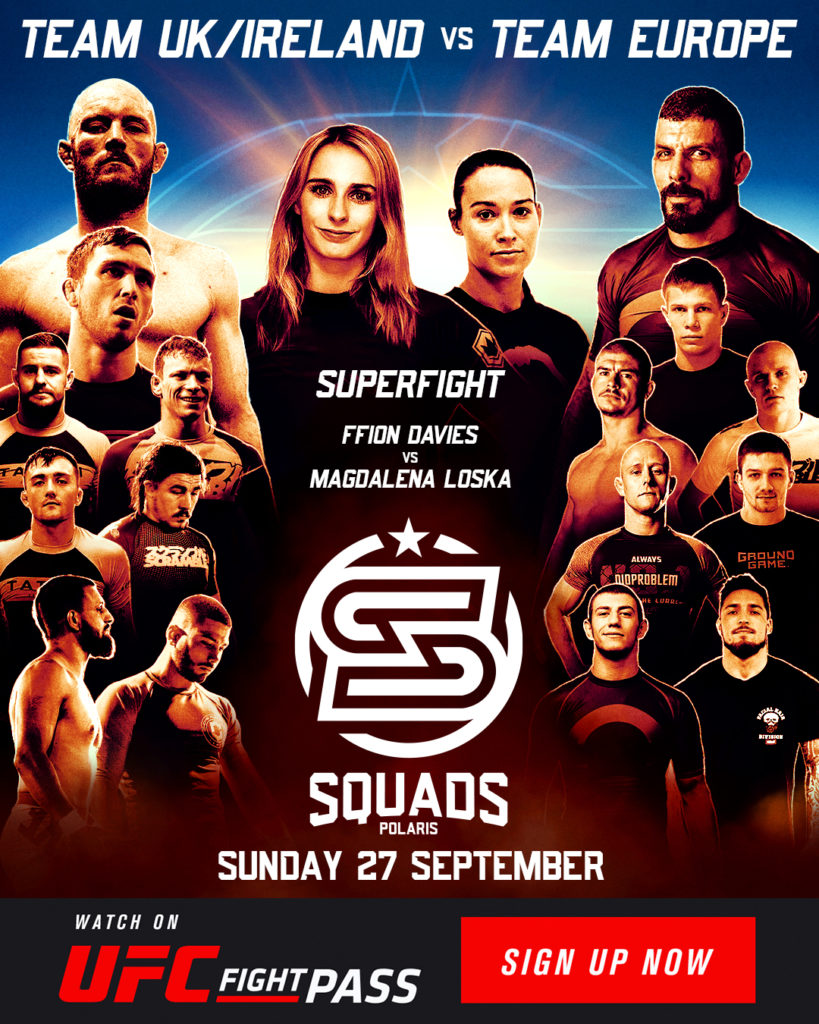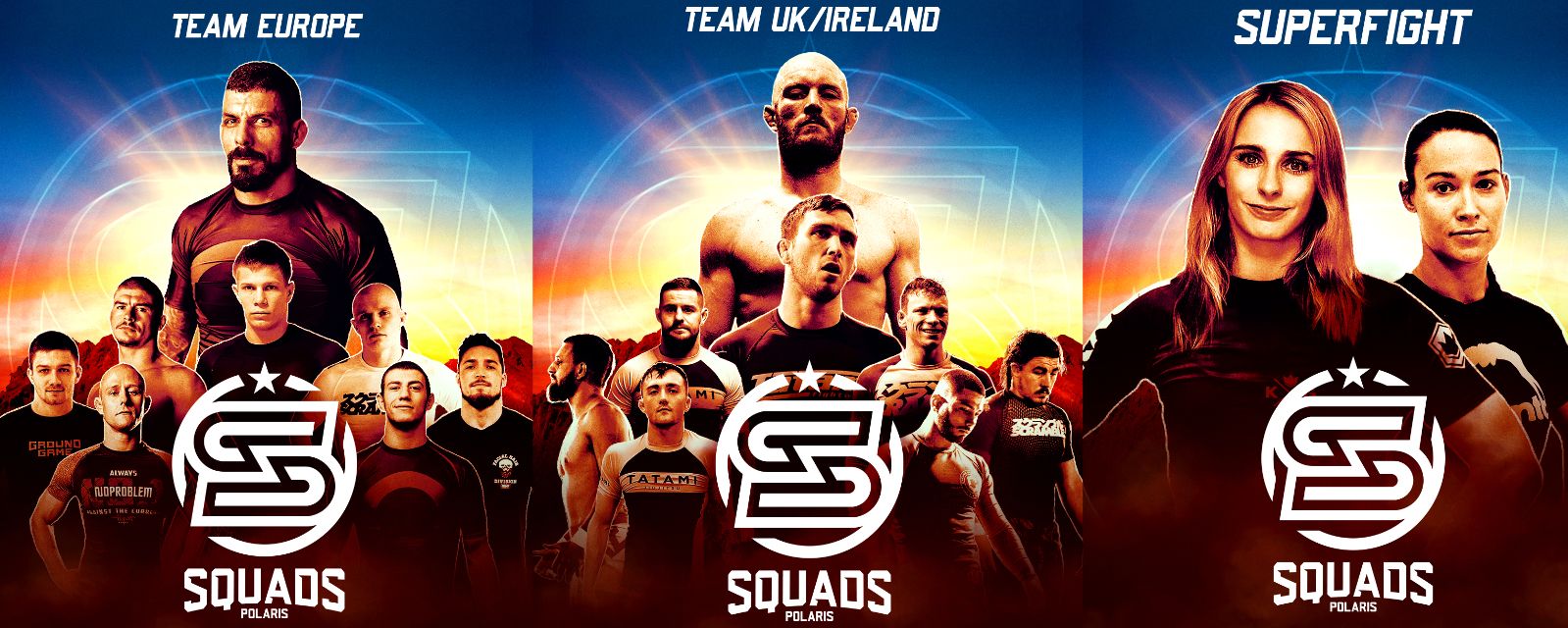Polaris Squads 1 will broadcast on UFC Fight Pass exclusively, on Sunday 27 September. It will be held in Southampton, England.
The event will featured Team UK & Ireland against Team Europe, with a superfight at half time.
Team UK & Ireland‘s representatives are as follows:
Under 75kg:
Tom Halpin
Jed Hue
Dominic Dillon
Ash Williams
Under 95kg:
Taylor Pearman
Bradley Hill
Kieran Davern
Darragh O’Conaill – Team Captain
Team Europe‘s representatives will be:
Under 75kg:
Mateusz Szczecinski
Tommi Pulkkanen
Kamil Wilk
Dinu Bucalet
Under 95kg:
Tarik Hopstock
Santeri Lilius
Marcin Held
Eduardo ‘Teta’ Rios – Team Captain
The Superfight will be a 10-minute feature bout between our women’s champion Ffion Davies and Polish challenger Magdalena Loska, under the Polaris Superfight rules.

Here are the rules of the new Squads format:
Polaris Squads
Polaris Squads is a revolutionary new team format grappling event with the aim of bringing the excitement and camaraderie of team sports, to grappling.
The Teams
There are eight members per team. Four members must be under 75kg and four members must be under 95kg. Teams can be centred around towns, nations, or team affiliations. The teams will each have a Team Captain, who acts as a focal point deciding competitor order on the fly and when to use timeouts. Team Captains will also come into play in the case of a draw at end of the event, explained later.
The Format
The event, at least in the first instance, is “no gi” with a compulsory team rashguard. All known submissions from IBJJF and ADCC are legal.
The event will have two 40-minute halves. During those halves, there will be a ‘winner stays on’ format. Each round (or match between competitors) is 5 minutes with a 30 second rest period in between.
Each team will send one competitor to the stage, who will battle for up to 5 minutes in a simple submission only ruleset. If it is a draw (ie there is no submission), both competitors will be off and two fresh competitors will step on the mat. Once a competitor is off (either by being submitted or by their match ending in a draw), they become ‘inactive’. They only become ‘active’ (and thus eligible to step on the mat) again once the whole team has been used. Competitors stepping to the mat are chosen “on the fly” during the 30 second break, except the first competitors of the event, who are chosen by their team captains in advance. Aside from the first competitors of the event, active competitors can be used in any order as selected by the Team Captain.
Active competitors – those eligible to be drawn on by the team captains to step on the mats – will be signified by wearing a team mesh bib as a quick and easy visual cue. Once a competitor is called to compete they will remove their bib and not put it back on again until the whole team has been used. Competitors wearing bibs are active and can be called on to compete, competitors not wearing bibs are inactive and must wait until all the active competitors have been used.
If a competitor submits someone from the other team, they will have 30 seconds to prepare themselves for the next challenger from the other team. The winning competitor also scores one point for their team. If a member of the under 75kg group submits a member of the under 95kg group, then they will score three points for the team. Points are only scored by submission wins.
Both teams can call up to two timeouts per half. A timeout can be called any time but only becomes active during the 30 second break. This turns the 30 second break into a 2 minute break, during which the team can rest, recuperate and plan their next move. The team that calls the timeout can also switch out their competitor – if the competitor won their match. For example, if Team A has won three in a row but the competitor is looking tired after those matches, a timeout can be called and that competitor can be swapped out for another active competitor (this is not compulsory – the timeout could just be called to give the winning competitor time to rest and talk to the team). If the team that calls the timeout decides to swap out the winning competitor, the competitor that has been swapped out is still “active” and can be called upon to compete again any time. The losing team could also call a tactical timeout ahead of the winning team – meaning that the winning team won’t have the option of resting their active competitor. ‘Counter timeouts’ cannot be called – timeouts are on a first come first served basis.
The winning team is the team with the most points, earned by submission wins, at the end of the 80 minutes.
In the case of a draw, there will be a 20 minute sudden death overtime extension during which the same rules apply – the first team to win by submission will win.
If the score is still tied after 20 minutes, the two team captains will compete against each other in one five-minute round under the Polaris Superfight rules – and if there is no submission, the judges will decide the winner based on aggression, submission attempts, and pushing the pace. (If a captain is legitimately injured before this then they may choose a substitute.)
Although the team environment and pressure to perform for the team should help to eliminate stalling, any stalling will be heavily penalised.
Single competitor stalling:
Referee notices stalling and starts stalling timer.
30 seconds of stalling = official warning
Next 30 seconds of stalling = 1 point taken away
Next 30 seconds of stalling = other competitor can choose dominant position (BACK, SIDE CONTROL, MOUNT)
If both competitors are stalling:
Referee notices stalling and starts stalling timer.
30 seconds of stalling = official warning
Next 30 seconds of stalling =
– If the stalling is taking place on the ground, both competitors will be forced to stand
– If the stalling is taking place standing, both competitors will be forced to start in the combat base position half a metre apart
If both competitors are warned for stalling but then only one competitor continues to stall, then conditions revert to ‘single competitor stalling’ guidelines
In a “one up one down” situation eg one competitor in seated guard, one competitor trying to pass, the competitor who is moving backwards will be considered the one who is stalling.
All stalling calls are reset once the athlete or athletes stop stalling.
Poor sportsmanship / fouls
- Attempting illegal submissions or manoeuvres
- Striking
- Any other breach of the rules
- In extreme cases the referee may disqualify or indicate that the judges are to mark a fighter down, at his discretion
Upon an infraction, the referee will pause the bout, warning the fighter (s) and pointing to the fighter (s) who is receiving a warning.
After two infractions, or at the referee’s discretion, the match can end, with the fighter committing the offences being declared the loser, and the opponent the winner.
Illegal Methods / Movements
Eye gouging or fish hooking
Grabbing fingers, ears, hair, toes, or other extremity
No posting on faces / one-handed windpipe grip
Slamming from above the knee height of the person doing the lifting to escape a submission or position (high amplitude throws / takedowns will not be penalised)
Repeatedly rolling off the mat to escape submissions will be treated in the same way as stalling – warning, point removed, then giving up position.
Legal Techniques
Chokes (except using fingers to crush windpipe)
Joint locks involving shoulder, elbow, wrist, knee, ankle. Neck cranks are legal in no-gi bouts.
Illegal in gi bouts: Spine / neck locks, heel hooks
General Rules
Winner is signified via tapout (at least two rapid taps on the opponent or mat), verbal submission (voluntary or involuntary), or being unable to continue the bout due to injury.
In no-gi bouts the athletes must not grip any clothing
Referee will be on stage to officiate the bout, ensure rules are followed and advise fighters when they get too near the edge of the mat, in which case they will be paused and returned to the centre of the mat in the same position. If no agreement on positioning can be made the athletes will be stood up at the centre of the ring.
Overall a high standard of sportsmanship is required before, during and after the fights.



